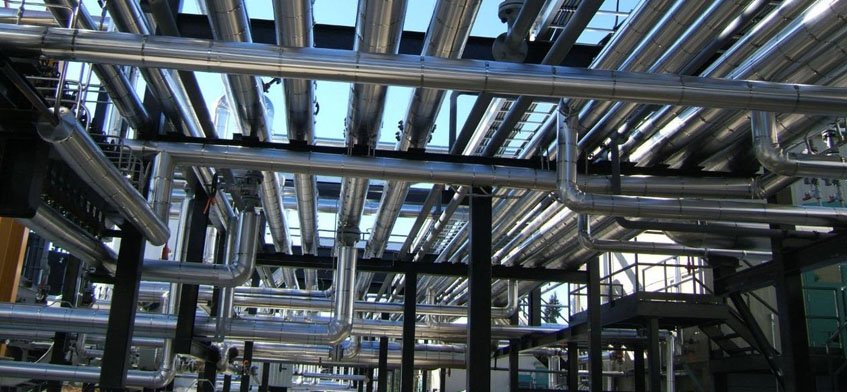INSULATION AND CLADDING SERVICES
The space requirements of the insulation must be taken into account when the installation is being designed and planned. Therefore, the insulation thicknesses should be determined in the early planning stages and the distances between the individual objects should be taken into account in the piping isometrics.
To select a suitable insulation system, the operating method of the installation must be considered. A basic distinction is made between continuous and interrupted operation. With continuous operation, the operating temperatures are constantly above or constantly below the ambient temperatures.
Installations that are situated outside are at risk from frost in the winter. In addition to the malfunctioning of installations, installations also risk damage caused by the expansion of frozen water. Moisture accumulation in insulation increases thermal conductivity and the risk of corrosion of the insulated installation components. Cladding must be installed to prevent the ingress of moisture into the system.
Surface temperatures in excess of 140 °F (60 °C) can lead to skin burns, if the surface is touched. Therefore, all accessible installation components should be designed to protect personnel and prevent injuries.
The general fire protection requirements imposed on structural installations are usually defined within the local Building Codes or the specifications of plant owner.
If there is a risk of fire and explosion, the surface temperature of the object and the cladding must be considerably lower than the ignition temperature of the flammable substance and/or gas mixtures.
The guidelines for noise in the ordinance and workplace are stated in the local regulations and standards.
In the industry there are two grades of insulation. The first grade focuses on reducing heat losses and the prevention of injuries to people operating or working nearby the installations.
The second grade of insulation, the so called “economical insulation thickness” focuses on significant heat loss reduction and as a result achieving a better return on investment.
Industrial facility disruptions are due to the lack of, or inadequate forms of, protection against corrosion. This considerably reduces the service life of industrial plants, and more frequently, essential shutdown or overhaul work impairs the efficiency of the installation.
In the case of cold insulation, if the object is made of non-alloy or low alloy steel, it must be protected against corrosion.
In the case of objects made, for example, of austenitic stainless steel or copper, the installation must be tested in each individual case by the planner to determine whether protection against corrosion is necessary.
Objects made from austenitic stainless steel do not require protection against corrosion if the temperature never – even for a short period – exceeds 120 °F (50 °C)
INSULATION OF PIPING
- Making sure the thickness of insulated pipe sections as per specification
- The insulators will be provided with safety aspects.
- The insulators will wear the nose mask at the time of working with the insulation material
- Cut the insulation material into profiles using cutter knife
- Apply approved adhesive in longitudinal seam and end faces of the insulation and entire pipe surfaces.
- Ensure pipe surface are clean prior to application of adhesive.
- Apply insulation with longitudinal seams at top of horizontal pipe runs.
- Apply pipe insulation with least n joints.
- Properly fix the approved insulation on the entire circumstances of the pipe to be insulated and pull sheet tight and smooth.
- Install same insulation material for flanges, elbows, fittings, and valves.
- Properly apply aluminum tape on the joints of insulation segments.
- Use manufacturer recommended tape to seal the joints in a way no air can penetrate through the joints
- Provision of removable type insulation sections to valves, including check valves, strainer basket and other valves.
- Close pipe penetration through roof, exterior wall interior wall, fire rated wall, floor, etc., through sleeves by ram packing with loose insulation and seal with approved mastic
CLADDING
- Apply flat or profiled aluminum cladding. Use sheeting 0.6mm thick on pipe work systems up to 150mm dia and 0.8mm on above 150mm dia and above.
- Informing use of pop up rivets is not acceptable due to high risk of damping the insulation vapor barrier an option is given using aluminum straps as per the specification requirements and according to manufactures recommendation and sample site mock up.
- Valves strainers and flanges will be provided with a split casing fabrication from 0.9mm aluminum sheet fitted with spring clips fasteners.
- Valve boxes will be designed to facilitate easy access and replacement for maintenance whilst ensuring the integrity of the vapor barriers.
- Where located externally joints between the box and the adjacent pipe insulating material and also around the valve stem will be sealed by non setting mastic.

